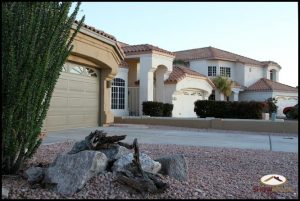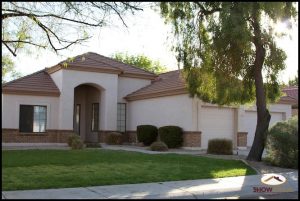2 June 2016
In desert suburb, homes in homeowners’ associations use less water, study finds
Posted by edeatrick
By Elizabeth Deatrick
After years of drought, desert communities like Phoenix, Arizona, are promoting low-water landscaping. But, while many in the region have embraced front yards of rocks and native shrubs, researchers at Arizona State University say some homes still use lots of water to maintain green lawns and leafy trees.

This home in Goodyear, Arizona has a desert-friendly yard with little vegetation and no grass. This kind of landscaping could help homeowners save thousands of gallons of water a month, according to a new study.
Image credit: Brandon Hunt (CC BY 2.0, via Flickr)
Lush landscaping increases home values, but these plants put unnecessary strain on the Phoenix metro area’s water supply, which comes mainly from rivers and underground reservoirs, according to Elizabeth Wentz, dean of social science in the College of Liberal Arts and Sciences and a professor in the School of Geographical Sciences and Urban Planning at Arizona State University in Phoenix.
The average home consumes 20,283 liters (5,358 gallons*) of water every month—enough to fill a large hotel swimming pool—30 percent to 65 percent of which goes towards outdoor use, she said.
“Curb appeal is incredibly important for the sale of a house,” Wentz said. “If you have a house with just rocks, and no vegetation at all [in the front yard], and another house down the street with trees and shrubs, the house with the vegetation is going to be priced higher.”
Now, a new study by Wentz and her colleagues finds that homeowners’ associations, or HOAs, are good for water conservation.
Local HOAs act as a committee to purchase neighborhood services, maintain common areas and ensure its members keep up appearances—including mandating the type of landscaping in a neighborhood. In the city of Goodyear, a suburb of about 73,000 people on the southwest border of Phoenix, homes that are part of HOAs use less water than their independent counterparts, according to the new study.
Despite the economic incentive to have a lush lawn, the study found homes in HOAs in Goodyear use up to 17,000 fewer liters of water (4490 gallons) in the peak month of July compared to their non-HOA counterparts, roughly the amount needed to fill eleven hot tubs. HOA homes in Goodyear used 30 percent less water in July, on average, than non-HOA homes during the same month, according to the study.
The new research published in Water Resources Research, a journal of the American Geophysical Union, proves the social power of the HOA, according to the researchers. Homes in HOAs are more likely to conform to the area’s social and environmental norms, even if those norms are never codified in law, they said.
The study’s authors suggest HOAs could reduce water use even further by pushing standards of beauty to reflect environmentally-friendly landscaping. By mandating new water-conscious standards of beauty—like xeriscaped yards that use hardy plants adapted to a desert environment—HOAs could coax their members into using less water overall, they said. The move could save thousands of gallons of water per household every year, Wentz said.
How do HOAs impact water use?
To determine the extent of a HOAs’ impact on water usage, Wentz and her team set out to compare similar homes in HOA and non-HOA neighborhoods.
The research team obtained water-use records for individual properties throughout several neighborhoods in Goodyear. . Collecting data from individual properties, rather than whole blocks, allowed the team to compare properties of similar size, Wentz said. The team also collected data on the vegetation in each home’s front yard: whether there were trees, bushes, a lawn, or other plants.
The team found houses in homeowners’ associations used significantly less water than those not in homeowners’ associations. They also had less vegetation overall. This was the case even when the HOAs listed minimum vegetation requirements in their rules, according to the new research.

In Goodyear, Arizona, shade trees and a lush green lawn can boost the curb appeal of homes like this one. But a new study suggests that the inviting landscaping will likely need much more water to maintain.
Image credit: Brandon Hunt (CC BY 2.0, via Flickr)
A sense of community, coupled with fines for non-conformers, can drive houses in HOAs to become more and more similar to each other, Wentz said. In addition, homeowners in HOAs often change their yards to blend in with their surroundings, according to previous research, Wentz said. In Goodyear, these factors lead to yards with drought-tolerant plants that already exist in the region, she said.
Reduced water use may not be the driving factor behind drought-friendly lawns in Goodyear’s HOAs, but it is one of the outcomes, Wentz said.
Evidence of conformity can be seen in HOAs in other areas of the country, according to Michael Dukes, an irrigation specialist and professor at the University of Florida in Gainesville who was not involved with the study.
In Arizona, for example, a lawn that’s too green would stand out from the others. “That’s the opposite of what we see here in Florida, where HOA properties have higher irrigation use,” Dukes said. “An HOA in Arizona would never get away with mandating the entire lot be vegetated, because it has to fit in with the natural environment.”
Wentz is curious to find out if communities can harness HOAs for more proactive water conservation. For example, if an HOA can write in a maximum vegetation requirement, the organizations could bring down water usage throughout dry suburban areas, she said.
“They’ve already been enforcing compliance on minimum standards [for vegetation in the yard], so establishing maximum standards wouldn’t be that much of a burden on homeowners,” she said.
— Elizabeth Deatrick is a science writing intern at AGU.
*Editor’s Note: This blog post originally included an incorrect number of gallons of water consumed by an average home in Goodyear. The correct number is 5,358 gallons.










 GeoSpace is a blog on Earth and space science, managed by AGU’s Public Information staff. The blog features posts by AGU writers and guest contributors on all sorts of relevant science topics, but with a focus on new research and geo and space sciences-related stories that are currently in the news.
GeoSpace is a blog on Earth and space science, managed by AGU’s Public Information staff. The blog features posts by AGU writers and guest contributors on all sorts of relevant science topics, but with a focus on new research and geo and space sciences-related stories that are currently in the news.